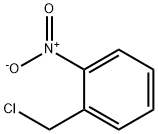α-Chlor-2-nitrotoluol
|
|
α-Chlor-2-nitrotoluol Eigenschaften
- Schmelzpunkt:
- 46-48 °C (lit.)
- Siedepunkt:
- 127-133 °C/10 mmHg (lit.)
- Dichte
- 1,556 g/cm3
- Brechungsindex
- 1.5557 (estimate)
- Flammpunkt:
- >230 °F
- storage temp.
- Store below +30°C.
- L?slichkeit
- ethanol: soluble98%
- Aggregatzustand
- Crystals, Crystalline Powder or Chunks
- Farbe
- Yellow to tan
- Wasserl?slichkeit
- Soluble in acetone, alcohol benzene, diethyl ether, and ethanol (98%). Insoluble in water.
- BRN
- 388396
- Stabilit?t:
- Stable. Incompatible with bases, moisture, acohols, oxidizing agents, amines. Corrodes steel.
- CAS Datenbank
- 612-23-7(CAS DataBase Reference)
- EPA chemische Informationen
- o-Nitrobenzyl chloride (612-23-7)
Sicherheit
- Risiko- und Sicherheitserkl?rung
- Gefahreninformationscode (GHS)
| Kennzeichnung gef?hrlicher | C | ||
|---|---|---|---|
| R-S?tze: | 34-36 | ||
| S-S?tze: | 26-36/37/39-45-27 | ||
| RIDADR | UN 3261 8/PG 2 | ||
| WGK Germany | 3 | ||
| RTECS-Nr. | XS9092000 | ||
| F | 19-21 | ||
| HazardClass | 8 | ||
| PackingGroup | II | ||
| HS Code | 29049090 |
| Bildanzeige (GHS) |

|
||||||||||||||||||||||||||||
|---|---|---|---|---|---|---|---|---|---|---|---|---|---|---|---|---|---|---|---|---|---|---|---|---|---|---|---|---|---|
| Alarmwort | Warnung | ||||||||||||||||||||||||||||
| Gefahrenhinweise |
|
||||||||||||||||||||||||||||
| Sicherheit |
|
α-Chlor-2-nitrotoluol Chemische Eigenschaften,Einsatz,Produktion Methoden
R-S?tze Betriebsanweisung:
R34:Verursacht Ver?tzungen.R36:Reizt die Augen.
S-S?tze Betriebsanweisung:
S26:Bei Berührung mit den Augen sofort gründlich mit Wasser abspülen und Arzt konsultieren.S36/37/39:Bei der Arbeit geeignete Schutzkleidung,Schutzhandschuhe und Schutzbrille/Gesichtsschutz tragen.
S45:Bei Unfall oder Unwohlsein sofort Arzt zuziehen (wenn m?glich, dieses Etikett vorzeigen).
S27:Beschmutzte, getr?nkte Kleidung sofort ausziehen.
Chemische Eigenschaften
liquidVerwenden
2-Nitrobenzyl chloride has been used to introduce the photo labile 2-nitrobenzyl protecting group for the phenolic OH group of tyrosine. It is used as a pharmaceutical intermediate.Allgemeine Beschreibung
Pale yellow crystals. Insoluble in water. Is thermally unstable.Air & Water Reaktionen
Insoluble in water.Reaktivit?t anzeigen
A halogenated aromatic nitro compound. Aromatic nitro compounds range from slight to strong oxidizing agents. If mixed with reducing agents, including hydrides, sulfides and nitrides, they may begin a vigorous reaction that culminates in a detonation. The aromatic nitro compounds may explode in the presence of a base such as sodium hydroxide or potassium hydroxide even in the presence of water or organic solvents. The explosive tendencies of aromatic nitro compounds are increased by the presence of multiple nitro groups.Health Hazard
ACUTE/CHRONIC HAZARDS: Toxic. Lachrymator. Causes irritation on contact. Hazardous decomposition products. Mutagen.Brandgefahr
2-NITROBENZYL CHLORIDE is combustible.α-Chlor-2-nitrotoluol Upstream-Materialien And Downstream Produkte
Upstream-Materialien
Downstream Produkte
612-23-7(α-Chlor-2-nitrotoluol)Verwandte Suche:
α-Chlor-5-methyl-2-nitrotoluol
α-Chlor-2-nitrotoluol
α-Chlor-2,4-dinitrotoluol
2-Nitrobenzoylchlorid
2-Nitrotoluol
α-Chlor-3-nitrotoluol
α-Chlor-3,5-dinitrotoluol
α-Chlor-2-methyl-3-nitrotoluol
α-Chlor-4-nitrotoluol
3-Nitrobenzoylchlorid
2,4-Dinitrobenzoylchlorid
α,4-Dichlor-2-nitrotoluol
- 1-Nitro-2-(chloromethyl)benzene
- 2-(Chloromethyl)nitrobenzene, alpha-Chloro-2-nitrotoluene
- 2-Nitrobenzyl chloride 99%
- 2-NITROBENZYL CHLORIDE
- A-CHLORO-O-NITROTOLUENE
- 2-NitrobenzylChloride98%
- à-chloro-2-nitrotoluene
- α-chloro-2-nitrotoluene
- ORTHO-NITROBENZYLCHLORIDE
- AKOS BBS-00004020
- ALPHA-CHLORO-O-NITROTOLUENE
- ALPHA-CHLORO-2-NITROTOLUENE
- O-NITROBENZYL CHLORIDE
- 1-(Chloromethyl) -2-nitrobenzene
- 1-(chloromethyl)-2-nitro-benzen
- alpha-chloro-o-nitro-toluen
- Toluene, alpha-chloro-o-nitro-
- 2-NitrobenzylChloride>
- 2-NITROBENZYL CHLORIDE FOR SYNTHESIS
- 1-(chloromethyl)-2-nitrobenzene
- Benzene, 1-(chloromethyl)-2-nitro-
- 612-23-7
- HALOGEN
- Nitro Compounds
- Organic Building Blocks
- Nitrogen Compounds
- Building Blocks







